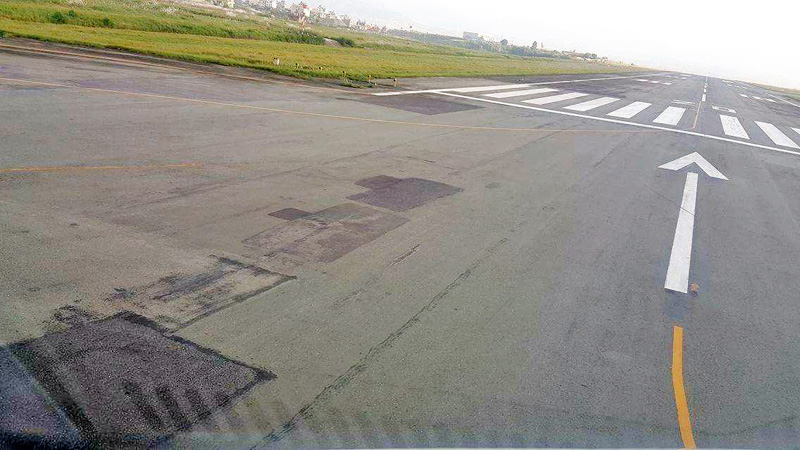TIA runway cracks widen as equipment worth millions gather dust
KATHMANDU: As the drama involving pathetic runway conditions and sub-standard maintenance continues at the Tribhuvan International Airport, the state of its mismanagement knows no bounds for the key stakeholders including passengers and airlines.
The TIA had just recently procured heavy equipment for what it called runway maintenance for better disaster preparedness, but they lie in the state of disuse after the procurement circus was over, clearly a point to the abysmal state of aerodrome management and lack of accountability here.
According to TIA officials, the disaster preparedness exercise of 2012-13 not only involved training key operations personnel in disaster management at the Pacific Disaster Center in Hawaii, but also the procurement of heavy duty pavement maintenance equipment.
“The heavy equipment - portable asphalt plant and concrete cutter- which were procured at a cost of nearly Rs 200 million, purportedly for disaster preparedness, have still been lying unused for over two years under open skies,” an official at the TIA Civil Engineering Division revealed.
The equipment are capable of producing six tonnes-per-hour of hot-mix asphalt needed for sizeable runway surface repairs in the event of disasters like earthquakes.
“But why it has not been used in service in the present state of emergency is simply inexplicable,” a station manager for an international airline wondered.
While the Hawaii exercise also involved preparations for a disaster response plan under assistance from the United States and Canada, stakeholders blamed that the procurement was essentially meant for spending the apportioned budget and pocketing the accompanying goodies such as foreign acceptance tests and training as well as the commission.
“The efficacy of the plan, tested shortly in the 2015 April earthquake, remains doubtful as the TIA then witnessed an utter chaos for over a month.”
Claiming that a team of technicians would measure friction and start removing rubber deposits from the runway threshold tomorrow, the TIA’s spokesperson Prem Nath Thakur, however, said that he had no idea about the status of any unused heavy equipment including asphalt plant and concrete cutter.
Interestingly, the TIA has hired technicians from other nations with necessary equipment spending millions of rupees this time after it failed to operate a water pressure rubber deposit removal machine and two runway friction measuring machines. The machines purchased under the TIA Improvement Project three years ago were lying idle in a state of disrepair, as the responsible officials had already pocketed the incentives that come along including all-paid foreign trips and handsome commissions, a senior TIA officer disclosed.
The sorry state of runway, purportedly designed for DC-10 aircraft, is also handling much larger aircraft with the explicit approval of TIA. It demonstrates the recklessness of Civil Aviation Authority of Nepal as a monopoly service provider while its regulatory wing is indulged in merrymaking of superficial audits, a senior NAC pilot commented.
A study report from the Ayesa Ingenieria Arquitectura of Spain and Aéroports De Paris Ingénierie of France has already revealed that the runway is not enough to handle wide-body aircraft due to its aging asphalt foundation.
“The damage to the lower asphalt layers is reflected quickly in the upper surface, resulting into the cracks and other damages to its surface.”
Besides, the TIA organogram shows that the Civil Engineering Division, which is responsible for the maintenance of aircraft movement surfaces - runway and taxiways - as well as building facilities, is led by a deputy director, who reports directly to the TIA General Manager, who is from a non-engineering background.
“This strangely conflicts with the practice in other engineering divisions like Electrical, Radar, Communication and Navigation that report through a director-level position,” a senior CAAN director said, adding, “This practice is clearly meant to exercise the control over sizeable maintenance-related expenditure while they take a back seat on runway and building upkeeps.”
READ ALSO:






